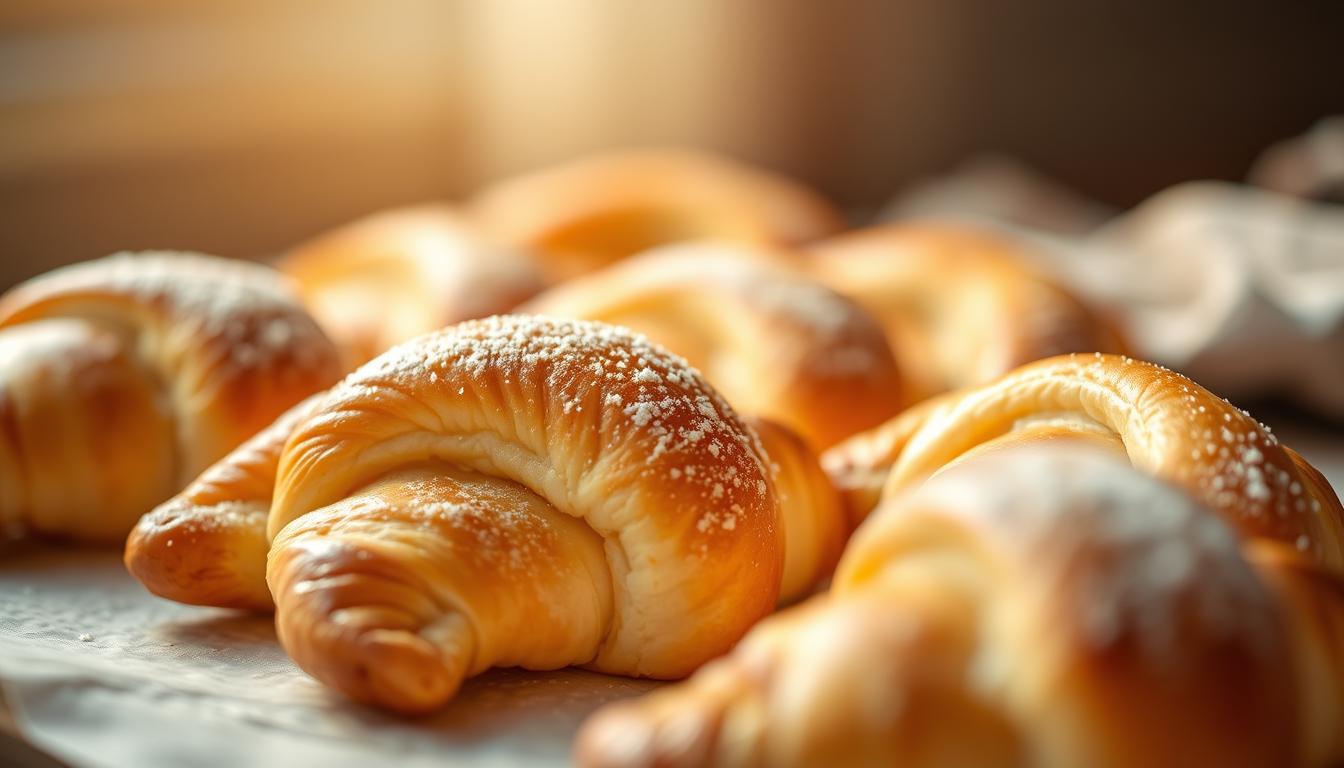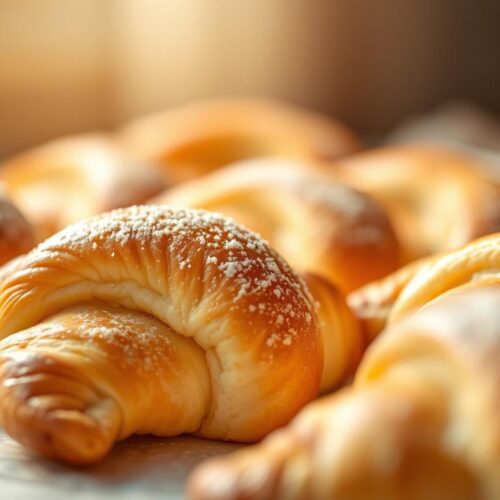How to Make Flaky, Buttery Swiss Gipfeli recipe at Home

Making flaky, buttery Swiss Gipfeli recipe at home is a fun experience. You just need the right ingredients and techniques. Gipfeli, a traditional Swiss pastry, is famous for its layered dough and rich taste, just like croissants.
To make perfect Gipfeli, using top-notch ingredients and following a detailed method is key. This guide will show you how to make Gipfeli at home, step by step.
With this croissant recipe easy guide, you can make delicious Gipfeli recipe just like bakery ones. Let’s start this tasty journey and discover Swiss Gipfeli.
Key Takeaways
- Understanding the basics of making Swiss Gipfeli recipe
- Importance of using high-quality ingredients
- Techniques for achieving flaky, buttery layers
- Step-by-step guide to making Gipfeli at home
- Tips for perfecting your Gipfeli-making skills
The Swiss Breakfast Tradition
The Swiss love their breakfast pastries, like the flaky, buttery Gipfeli. This favorite pastry is found in Swiss bakeries and homes. It’s often enjoyed with a warm coffee or tea.

What Are Gipfeli?
Gipfeli are Swiss pastries similar to croissants but with their own twist. They’re made with a special dough that makes them flaky and rich in buttery flavor.
Gipfeli vs. French Croissants
Gipfeli and French croissants are both tasty, flaky pastries. But, Gipfeli are less flaky and have a unique texture. This makes them stand out in the world of breakfast treats.
Essential Ingredients for Perfect Gipfeli recipe
To make authentic Swiss Gipfeli, start with top-notch ingredients. They ensure a flaky and buttery pastry. The right ingredients boost flavor and create the signature layered texture of Gipfeli.
Flour Selection
The base of Gipfeli is a strong, high-protein flour. Choosing a flour with a protein content between 12% to 14% is crucial. This is key for the dough’s structure and elasticity.
Butter Quality Matters
High-quality European-style butter is best for Gipfeli. It has a higher fat content, which is vital for flaky layers. The butter should be cold and of high quality for the best results.
Other Key Ingredients
Other must-have ingredients include yeast, sweeteners, salt, and dairy components.
- Yeast helps in fermentation, giving Gipfeli its light texture.
- Sweeteners and salt balance the flavor. Sugar adds sweetness, and salt enhances the taste.
- Dairy components like milk make the Gipfeli rich and tender.

By using these essential ingredients, you can make a Gipfeli recipe that tastes like the real Swiss pastry.
Equipment You’ll Need
Getting your kitchen ready with the right tools is key to making perfect Gipfeli. The right equipment makes the process easier and ensures your Gipfeli are flaky and tasty.
Baking Tools
You’ll need some basic baking tools to start. A mixing bowl and a measuring scale are essential for mixing ingredients right. A pastry scraper helps with handling the dough.
Also, a baking sheet lined with parchment paper is needed for baking your Gipfeli perfectly.
Optional but Helpful Equipment
Some tools are not necessary but can make things easier. A pastry laminator helps with lamination, creating even layers of dough and butter. A dough proofing basket can also be helpful for a professional look.
The Perfect Swiss Gipfeli Recipe
Making flaky, buttery Swiss Gipfeli starts with a precise recipe. It’s key to follow a tested method for the authentic taste and texture.
Ingredient Measurements
First, collect the needed ingredients in the right amounts:
| Ingredient | Quantity |
|---|---|
| Flour | 2 cups |
| Butter | 1 cup |
| Yeast | 1 tsp |
| Salt | 1/2 tsp |
| Sugar | 1 tbsp |
| Milk | 1/2 cup |
Preparing the Dough
Start by mixing the dry ingredients (flour, yeast, salt, and sugar) in a big bowl. Add the milk slowly until the dough is smooth. Knead for 10 minutes until it’s elastic. Then, cover it and chill in the fridge for 2 hours.
Creating the Butter Layer
While the dough chills, make the butter layer. Soften the butter, then roll it into a rectangle, about 1/2-inch thick. Make sure the butter is spread evenly for easy lamination later.
By following these steps, you’re on your way to making delicious Swiss Gipfeli. The secret is in the layering, which needs patience and care.
Mastering the Lamination Process
Making flaky, buttery Gipfeli is all about mastering the lamination process. This method involves layering dough and butter. It creates the flaky texture found in Gipfeli and croissants, a key part of many pie recipes.
First Fold Technique
The first fold is key in setting up the layers for Gipfeli. Roll out the dough to the right thickness, then add a layer of high-quality butter. Fold the dough in a specific pattern, like a tri-fold or letter-fold, to start the layers.
Resting Periods
Resting periods are crucial in the lamination process. After each fold, the dough needs to rest in a cool place. This lets the gluten relax, making the dough easier to roll out for the next fold.
Completing the Folds
To finish the lamination process, repeat the folding and resting steps several times. There are two main methods:
- Single Fold Method: A simpler technique with just one fold.
- Double Fold Method: A more complex method with two folds, making more layers.
Each method has its own benefits. The choice depends on what you want to achieve and your personal preference.
Time Management for Gipfeli Recipe Success
Making Gipfeli is a multi-step process that needs careful time management. This ensures you get the perfect flaky, buttery pastry. It’s important to plan your time well.
Here’s a breakdown of the process over two days:
Day1: Dough Preparation
Start by preparing the dough and letting it rest overnight. This step is key for developing the dough’s flavor and texture.
Day2: Lamination and Baking
The next day, do the lamination, shape, and bake the Gipfeli. This step needs attention to detail for the signature layers.
Quick One-Day Timeline Option
If you’re short on time, you can make the Gipfeli in one day. But, you’ll need a more condensed timeline and careful planning. Be prepared to work efficiently to get the best results.
Shaping Your Gipfeli
Shaping Gipfeli needs patience and a soft touch. To get the perfect crescent shape, you must cut and roll the dough carefully.
Cutting the Dough
Begin by cutting the dough into triangular pieces. Precision is key for uniform Gipfeli. Use a sharp knife or pastry cutter to avoid tearing the dough.
Rolling Perfect Crescents
Roll each triangle into a crescent shape, starting from the wide end. Gentle pressure is crucial to keep the layers and avoid squeezing out the butter. Make sure the tip is tucked under the Gipfeli to prevent it from unfolding during proofing.
Arranging for Proofing
Place the shaped Gipfeli on a parchment-lined baking sheet, leaving enough space for even proofing. This step is key for the right texture and flavor in your homemade Gipfeli. It makes your croissant recipe easy to perfect.
Proofing and Baking
Proofing and baking are key steps for perfect Gipfeli. After careful lamination, these steps are where patience really pays off. Your dough will turn into golden, flaky pastries.
Final Rise Time
The final proofing stage is very important. Let your shaped Gipfeli rise in a cool, draft-free place for 1 to 2 hours. They should double in size. This step is crucial for the layers and texture.
Egg Wash Application
Before baking, brush your Gipfeli with an egg wash. Mix beaten egg with a bit of water or milk. This gives them a rich, golden color. Be gentle to avoid damaging the layers.
Oven Temperature and Timing
Preheat your oven to 400°F (200°C). Bake your Gipfeli for 15-20 minutes, until they’re golden brown. Here’s a more detailed guide:
Conventional Oven Settings
Bake on the middle rack for even browning. Rotate the baking sheet halfway through.
Convection Oven Adjustments
Lower the oven temperature by 25°F (about 15°C). Check for doneness a few minutes early, as convection ovens bake faster and more evenly.
Troubleshooting Common Gipfeli Problems
Making Gipfeli is more than just a recipe. It requires solving common problems like butter leakage, uneven rising, or flaky layers. Knowing how to fix these issues is essential for perfect Gipfeli.
Butter Leakage Issues
Butter leakage can happen if you don’t laminate right or if the dough doesn’t rest enough. Make sure your butter and dough are at the right temperature. Also, keep the layering process correct.
Dough Not Rising
If your dough isn’t rising, it might be old yeast or wrong proofing temperatures. Always check your yeast’s expiration date. Also, make sure your proofing area is warm and draft-free.
Achieving the Perfect Flakiness
Flaky Gipfeli, like croissants or pie crusts, need proper lamination and gentle dough handling. Keep your ingredients cold and handle the dough as little as possible for the best texture.
Gipfeli Variations to Try
Mastering the classic Swiss Gipfeli recipe is just the start. Now, it’s time to explore exciting variations. You’ll learn about chocolate-filled, almond, and whole wheat options.
Chocolate-Filled Gipfeli
Chocolate lovers will adore filling Gipfeli with dark or milk chocolate. Place a piece of chocolate in the dough before rolling it into a crescent shape. Make sure the chocolate is well-covered to avoid oozing during baking.
Almond Gipfeli
Almond Gipfeli mix almond paste or sliced almonds into the dough. You can also sprinkle sliced almonds on top before baking. They’re perfect with a warm coffee or tea.
Whole Wheat Option
For a healthier choice, use whole wheat flour instead of all-purpose flour. Whole wheat Gipfeli are denser and have a nuttier taste.
| Variation | Description | Taste Enhancement |
|---|---|---|
| Chocolate-Filled | Filled with dark or milk chocolate | Rich, chocolatey flavor |
| Almond | Incorporates almond paste or sliced almonds | Nutty, slightly sweet |
| Whole Wheat | Uses whole wheat flour | Dense, nutty flavor |
Make-Ahead and Storage Tips
Want to enjoy your Gipfeli for longer? Our make-ahead and storage tips can help. Preparing Gipfeli in advance is easy with the right methods.
Freezing Unbaked Gipfeli
Freezing unbaked Gipfeli is a smart move for future baking. Just place the shaped, unbaked Gipfeli on a baking sheet lined with parchment paper. Then, put it in the freezer until they’re solid.
After that, move them to a freezer-safe bag or container. This way, you can bake fresh Gipfeli whenever you like.
Reheating for Maximum Freshness
To reheat frozen Gipfeli, bake them straight from the freezer. Preheat your oven to 375°F (190°C). Bake for 15-20 minutes, or until they’re golden brown.
For an easy croissant recipe, follow this simple reheating method. Enjoy freshly baked Gipfeli every time.
Conclusion
Now you can make flaky, buttery Swiss Gipfeli at home. It’s a bit like making natasha baking croissant. It takes patience and practice, but it’s worth it.
By mastering the lamination and using quality ingredients, you’ll make a delicious croissant pie. Your family and friends will love it.
Try adding chocolate or almonds to your Gipfeli for a special touch. As you get better, baking Gipfeli will become fun. You’ll enjoy sharing freshly baked croissants with others.
FAQ
What is the difference between Gipfeli and croissants?
Gipfeli and croissants are both flaky, buttery pastries. But, they differ in ingredients, texture, and taste. Gipfeli use yeast dough and are denser than French croissants.
Can I use a croissant recipe to make Gipfeli?
Some croissant recipes can be adapted for Gipfeli. But, traditional Gipfeli recipes use specific yeast dough and lamination. A recipe made for Gipfeli will give better results.
How do I achieve the perfect flakiness in my Gipfeli?
For flaky Gipfeli, mastering lamination is key. This means folding and rolling the dough many times. Cold butter and the right flour also help.
Can I make Gipfeli ahead of time and freeze them?
Yes, you can freeze unbaked Gipfeli. Shape the dough, freeze on a baking sheet, then bag them. Thaw and proof as the recipe says when you’re ready to bake.
What are some variations of Gipfeli recipe I can try?
Try different flavors like chocolate-filled or almond Gipfeli. You can also use whole wheat dough or add nuts and seeds for extra texture and taste.
How do I store baked Gipfeli to keep them fresh?
Store baked Gipfeli in an airtight container at room temperature for up to 2 days. Freeze them for longer storage. Reheat in the oven or microwave when you want to enjoy them.
Can I make Gipfeli using a stand mixer or food processor?
Stand mixers or food processors can help with dough. But, be gentle and avoid overworking. Finish by hand to get the right texture.
How do I know when my Gipfeli are done proofing?
Gipfeli are ready when they’ve doubled in size and feel light and airy. Check by pressing gently; if it springs back slowly, they’re ready to bake.
Can I use a gipfeli recipe to make other types of pastries?
Yes, making Gipfeli can help you learn skills for other pastries like croissants or Danish pastries. Try different recipes and ingredients to improve your skills and find new favorites.

Gipfeli recipe
Ingredients
- 500 g all-purpose flour
- 1 tsp salt
- 2 tbsp sugar
- 20 g fresh yeast or 7g dry yeast
- 250 ml warm milk
- 1 egg
- 200 g cold butter for laminating
- 1 egg yolk + 1 tbsp milk for egg wash
Instructions
- Prepare the dough
- In a bowl, mix flour, salt, and sugar. Dissolve the yeast in warm milk and add to the flour mixture with the egg. Knead until smooth and elastic (about 8–10 minutes). Cover and let rise for 1 hour or until doubled in size.
- Prepare the butter block
- Place the cold butter between two sheets of parchment paper and roll into a rectangle (about 20x25cm). Chill until firm but pliable.
- Laminate the dough
- Roll out the dough into a 40x30cm rectangle. Place the butter in the center and fold the dough over it like an envelope. Roll out and fold into thirds. Chill for 30 minutes. Repeat the rolling and folding process 2 more times, chilling between each fold.
- Shape the Gipfeli
- Roll the dough into a large rectangle (about 30x40cm). Cut into 8 long triangles. Roll each triangle from the base to the tip to form the classic croissant shape. Place on a baking tray.
- Final rise
- Let the shaped Gipfeli rise for 30–45 minutes at room temperature.
- Bake
- Preheat oven to 200°C (390°F). Brush the Gipfeli with egg yolk + milk. Bake for 15–20 minutes until golden brown.
